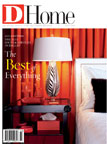 | James McInroe and his corgi, Lyle. Vintage French velvet fabric covers the windows of his bedroom. This Frette blanket cover is washable, which makes it ideal for anyone with pets, says McInroe. |
McInroe’s Little Shop of Color
Experimentation and flux rule in James McInroe’s home-cum-design laboratory.
 |
| The centerpiece of the dining room is a sculptural, brass chandelier, c. 1975; French Moderne mahogany table and Art Deco style chairs; orange Scandanavian and Murano glass; white Portuguese pottery vases. |
“The sort of tone-on-tone bowl of oatmeal is not for me,” says James McInroe, whose chunky black glasses and bleached hair give him an Elvis Costello-meets-Billy Idol quality that’s smart and stylish, like the rooms he decorates. No boring breakfasts here. He’s more of a Fruit Loops guy who prefers a crunch of color in the mornings. In the past, he’s painted a bedroom a disquieting shade of chartreuse, while the current boudoir blazes in burnt orange velvet. He claims he sleeps just fine.
“My bedroom is the best room in the house,” he says. “I could never have sold this room to a client. All the elements in it, when taken separately – the orange velvet curtains, white patent leather headboard and zebra lamps – sound bizarre, but when they come together it’s very refined, like an Herm’s showroom or a posh hotel”.
McInroe often brings clients to his house to show them how aggressive color combinations and dramatic contrasts of periods and styles can create sophisticated looks. His gracious, 1925 historic duplex in Perry Heights has become a laboratory for mixing it up. “It’s a sort of combination house and studio where clients can see examples of my style,” he says. “I appreciate objects from a great variety of periods. I really like the juxtaposition of something very old with something new. The Barcelona chair with the Biedermeier table in the living room is an example, so is the antique Chinese screen in the bedroom next to the patent leather headboard.”
 |
| Sheer white hotel shower curtains on ceiling tracks cover unsightly areas of the kitchen. Art Deco outdoor table in its original blue patina; c. 1970s office chairs covered in white hair hide and leather. The ceiling fixture is a plastic imitation of spun glass, c. 1960-70. |
It can be unsettling to live in a lab experiment. At any moment, anything in the house might be sold out from underneath him. If a client likes what she sees, it sometimes goes home with her. Price tags dangle from furniture like tree ornaments, and clients furniture often crowds out McInroe’s own. “A client’s chair may be back from the upholsterer and I have to stick it somewhere,” he says. “Things of mine can get booted out the door so that we can show a client a coffee table. The place can change dramatically in the span of a week. It really does impact the way the house looks on a given day.”
Like most designers, McInroe gets bored easily. Switching out furniture routinely is a way to combat aesthetic ennui and put bread on the table. He does this ruthlessly. “I get attached to certain vintage clothing, or my Louis Vuitton Epi luggage, but I honestly can’t think of any piece of furniture I wouldn’t sell,” he says. “If I become attached, I stop eating. There’s nothing I wouldn’t sell in this house except the dog.”
Despite – or because of – the flux, McInroe adheres to a series of tried-and-true colors for the walls. Natural light from the many windows in the living room begged for a soft hue, so he painted it a favorite blue gray by Farrow & Ball. “Not many subtle colors hold up to the chartreuse in the dining room,” he says. “But this one does.” The dining room is painted the same color as the aforementioned chartreuse bedroom, and a color that McInroe views as a staple in his arsenal of razzmatazz room colors. “That chartreuse will follow me around forever,” he says. “It took me a long time to find the right one. Yellows and chartreuses can be difficult because they can turn too buttery or bright at moment’s notice. This one holds up.”
 |
| Sun illuminates the pale-blue Venetian glass vases and lamps in McInroe’s living room. Table is draped in Fortuny linen fabric. |
McInroe doesn’t have patience with decorators’ lists of what’s hot or not. His kitchen is painted turquoise, a former “it” that has recently fallen out of fashion. “I’m not going to cover the world in it, but I’m also not bowing to the people who say I can’t use it any more.” Chocolate brown walls arrived with Billy Baldwin in the 1950s, and, according to McInroe, are also as chic as ever. In the bedroom, Hershey’s milk chocolate walls peek out beneath the orange curtains. “I’ll always use variations of chocolate browns,” he says.
Bold color is signature McInroe, but it’s no panacea. Bad design can’t be painted over. Using McInroe’s test-lab approach, let’s try an experiment: Imagine his Technicolor rooms in old-fashioned black and white. Without the distraction of color, the composition of objects and placement of the furniture stand out. There’s an underlying harmony to the overall design, which is, frankly, critical when working with colors that can turn people off as easily as they turn them on. “As important as color is to me,” says McInroe, “meticulous and precise placement of things is more important. Often moving an object an inch one way or another, or where a chair leg goes in a room, makes the most difference in how a room feels.”
———————–
 |
| James McInroe’s bedroom is brown, but the French 1970s orange velvet curtains make it sizzle in a burnt orange hue. A black lacquer side table was made in the 1930s and holds a plethora of Hermes orange accessories and orange Venetian glass pieces. The zebra-striped glass lamp is Venetian; McInroe designed the white patent vinyl headboard with chrome nailheads. |
A Color Primer
James McInroe’s practical tips on using color in your house
Brighter colors in paint are easier to predict than complex neutrals. Its easy for beige to go too pink or too green or lavender. A strong color on a paint chip will usually be what you perceive it to be once you get it on the walls.
Never put any color on the wall without first testing it in at least a 3 feet by 3 feet patch
Paint over the trim and molding with the wall color unless it’s deserving of being shown off, then make it contrasting.
It’s interesting to silhouette a different color on the ceiling with a different color on the walls. I often do different variations of sky blue.
Look at color the way you put on clothes. Pair a bright tie with a neutral suit. Silhouette colors against each other like you would with fashion. Right now I’m standing in the living room, looking at my yellow dining room and past that into the turquoise kitchen. I’m reminded why I painted them those colors in the first place, because I like seeing the impact they make against each other.
If walls are colorful, you can make very simple statements with neutral rugs like sea grass and sisal. You don’t have to spend much money for high impact.




